Five Years With Pismo
by Charles W. Moore
Five years ago this month I took possession of my Pismo PowerBook. It was already a year old at the time, so it’s now really six, but I’m personally marking the half-decade with it.
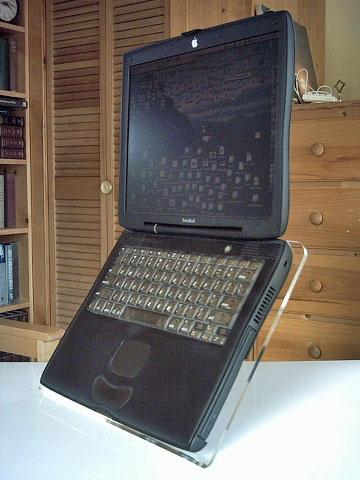
I traded a barely-used G4 Cube for the year-old Pismo The Cube, which I had purchased five months earlier, was fast, quiet, and came with a great set of Apple Pro satellite speakers. At the time its 576 MB of RAM made it seem like I would be able turn off Virtual Memory forever. The Apple Pro Keyboard and optical mouse were spectacular looking, and the 20 GB hard drive provided lots of room.
However, what I didn’t like about the Cube was that it was too big, or more precisely, the Cube CPU module itself was quite compact, albeit surprisingly heavy, but when combined with all the peripheral stuff it required, it was a lot bigger package than a PowerBook. It also had no battery. , which meant that during power failures, which are not unheard of out here in the woods, it would be not be usable, and there was of course increased likelihood of data loss.
I did like the Cube. It was a very cool machine. However, it was also very much a desktop computer, and laptop guy, and a respondent to my online classified ad asked if I would entertain the notion of trading the Cube for a used Pismo.
It sounded like a pretty nice Pismo on paper, with 500 MHz, 256 MB of RAM, and a 20 GB hard drive, as well as VST Zip and SuperDisk expansion bay modules. I decided that this could be an attractive deal if the the machine lived up to its description, which happily it did. Not in mark on it, it seemed to work perfectly, and there were no dead pixels. According to its serial number, the machine was built in the 39th week of 2000.
My first impressions of the Pismo in use were also positive, although at slightly more than twice the clock speed and twice the backside cache capacity of my WallStreet, it actually didn’t seem a whole lot faster than the older G3 PowerBook for most of the things I do. The 500 MHz PowerBook was definitely slower than the 450 MHz G4 Cube had been. I had hoped that the 50 MHz faster, albeit G3, Pismo would offer decent performance under OS 10.1, but I wasn’t impressed with that.
Finder performance on the Pismo actually seemed slower than on the WallStreet, which sounds bizarre, but it was a distinct and consistent impression. The culprit, I suspect, was the response capability of the Pismo’s 20 GB Toshiba hard drive, which seemed to be a bit lazy compared with the 10 gigabyte Toshiba drive in the WallStreet. On the other hand, the 40 GB unit was satisfyingly quiet, and remained so until I replaced it with a 40 GB 5400 ROM unit, but I’m getting ahead of myself.
This machine also ran cool - some 10° - 30° cooler than the WallStreet did under similar use in the same environment, even though the WallStreet had less than half the Pismo’s clock speed.
The Pismo’s 14.1 in., 1024 x 768 screen felt pleasantly expansive compared with my WallStreet’s 12.1 in., 800 x 600 unit, although it’s note the greatest display in the world, being a tad grainy and dull compared with the wonderfully bright and sharp 12.1” 1024 x 768 display in my G3 iBook. At six, I think the backlight tube is dimming somewhat as well, although it’s still very usable.
The bronze keyboard in the Pismo is excellent, although I still think the WallStreet’s ‘board edges it a bit for overall feel and comfort. The WallStreet has a better trackpad, too, although a worse trackpad button, and the Pismo’s is way too stiff for my taste as well.
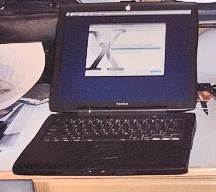
Disappointingly, FireWire throughput seemed noticeably slower through the Pismo’s FireWire ports then it did using a MacAlly FireWire PC Card adapter on the WallStreet, and the FireWire bus in the Pismo and first generation PowerBook G4s was indeed noted for being sluggish. On the other hand, the ability to boot into FireWire Disk Mode makes the Pismo conveniently compatible with modern Macs, and I for instance was able to use the Pismo via Target Disk Mode to install OS X Tiger on my DVD drive-less iBook. This particular Pismo came with VST Zip and SuperDisk expansion bay modules, so I could actually use floppies with it when running OS 9. Built-in DVD was nice to have as well.
I continued using the WallStreet for my production machine, while the Pismo was dedicated to being my OS X transition platform - the role the Cube had been originally purchased to fill. I had initially anticipated a fairly quick switch to OS X, but frankly, the performance of OS 10.1 was just not acceptable on the Pismo for production work, and OS 10.2 was not enough of an improvement for me to abandon OS 9.1, and it wasn’t until the WallStreet suddenly died from what turned out to be a processor coronary (it was subsequently revived with a daughtercard transplant) on August 1, 2002, that I started using the Pismo (in OS 9.1) as my production Mac.
By that time I had swapped of one of the 128 MB RAM models out to replace it with a 512 MB unit, bringing the total RAM up to 640 MB - the first of several hotrodding tweaks I done to this machine over the five years of ownership (the Pismo came wit PC-100 SO-DIMMs, but PC-133 will also work). It wasn’t until OS 10.3 Panther was released in October, 2003, that OS X performance on the Pismo improved to the point that I finally stopped using OS 9.x for production work on the Pismo. The Classic OS was still faster by a considerable margin, but with Panther, OS X had finally crossed my threshold of tolerability. On the other hand, I never used OS 9 for production on the 700 MHz G3 iBook I purchased in January, 2003, which came with OS 10.2.3 installed. My take is that it was the iBook’s RADEON 7500 GPU and 16 MB of video RAM that made most of the difference rather than the 200 MHz of extra clock speed.
Indeed, after I bought the iBook, the Pismo sort of got shelved for a while. I liked the iBook’s screen a lot better, and it was faster, so why not? Then, once OS 10.3 was installed, the Pismo actually seemed faster than the iBook, which didn’t seem to derive nearly as much of a turbo - boost from the Panther upgrade as the Pismo did.
The Pismo really got its second lease on life, so to speak, in January, 2004, with the installation of a Daystar MAChSpeed G4 PISMO 550 MHz G4 processor upgrade, which I would rate an unqualified success, having been fast, bug-free, and totally trouble-free for going on three years now.
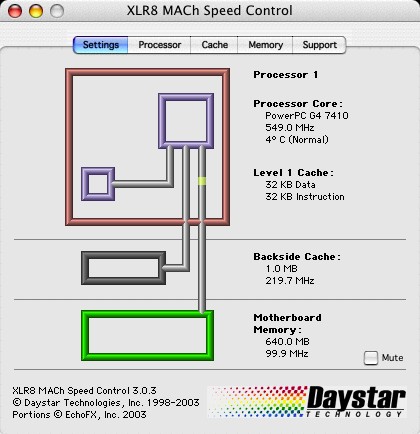
To say that I’ve been pleased with the upgrade is an understatement. I’m delighted. The most accurate descriptive term for this upgrade I can think of is “elegant.” Aside from the improvement in speed, I would have no indication that there was anything different about my PowerBook..The upgraded 550 MHz G4 Pismo was now significantly faster than my 700 MHz G3 iBook. For example, the system optimization when I installed Safari 1.2 on the iBook took about 22 minutes. With the G4 Pismo it was about 14 minutes.
The next phase for my hotrodded Pismo was a 40.0GB Toshiba MK4019GAX 5400 RPM drive with a 16MB data buffer. Installing the drive in the Pismo was a relative breeze. It’s gratifying how easy these G3 Series ‘Books are to open up and work on. The performance increase from the 1,200 RPM faster drive was not as impressive as I’d hoped, and the faster drive was noisier, but the extra space was very welcome, although it’s now getting filled up again.
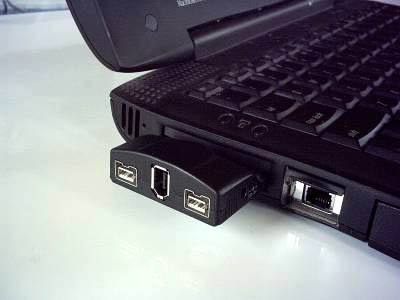
Then came a Miglia Alchemy FW 800 PC Card, which finally made use of my Pismo’s single PC card slot. Installation was dirt-simple. I just slid the card into the CardBus bay, clicked it home, and it showed up as a menulet in the OS X menu bar, and worked perfectly, giving the old PowerBook access to all FireWire devices, old and new - something unavailable to iBook, 12” PowerBook, and even MacBook owners.
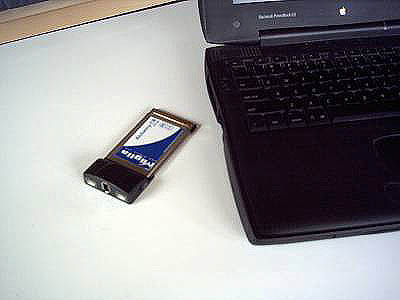
My next hotrodding tweak was adding a FastMac 4x SuperDrive expansion bay module, that was subsequently superseded with an 8x Fastmac unit. Both of these drives have been superb performers, and of course with the Pismo’s expansion bay, installing them is utter simplicity.
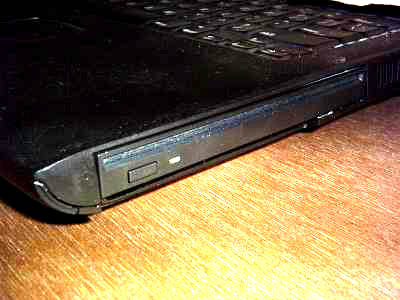
Just pull the release lever for the right-hand device bay on the front of the Pismo, slide out the OEM 6x DVD-ROM drive (or whatever module happens to be occupying the bay), and slide in the SuperDrive module. Takes less than 10 seconds. The FastMac SuperDrives are both slot-loading units unlike the Pismo’s stock, tray-loading DVD-ROM drive. Consequently, they changes the appearance of the right front corner of the Pismo slightly, and don’t quite have the finished look of the OEM drive or even the VST modules, but they looks perfectly fine to me.
One aspect where my Pismo experience has not shone is batteries. The original (presumably) battery died suddenly in October 2003. The palm rest over the battery compartment became extraordinarily warm to touch, and then the battery went stone cold dead. Perhaps I’m lucky that it didn’t catch fire!
At the time, I opted for a used unit that I got for about $80. A bad decision and false economy as it turned out. The replacement battery (an OEM Apple unit), worked fine when it arrived and for few months subsequent, but then began giving only about fifteen minutes runtime on a full (?) charge. It turns out that that battery had experienced a lot of discharge/charge cycles.
So last December, I replaced the battery again, this time with a NuPower ‘EXTRA’ High Capacity 6600mAh model with an advertised 37.5% greater capacity than Apple’s OEM Pismo Battery. I have absolutely no complaints about the NuPower battery, which provides astonishingly long runtime ( and it’s not even the highest capacity Pismo battery Newer Technology offers for the Pismo. If you need even more capacity, FastMac has just announced a new 84 Watt hr. TruePower Pismo replacement battery claimed to to provide up to 68% more capacity than the original Apple battery, and which is also available bundled with a Fastmac a G4 550 MHz processor upgrade. “With 2 battery bays and our G4 upgrade, you can literally go half-way around the world without a recharge,” says Michael Lowdermilk, Business Development Manager for Fastmac Performance Upgrades, Inc. For more information, visit:
http://www.fastmac.com/
When OS 10.4 Tiger was unleashed in the spring of 2005, I duly installed it on the Pismo and the iBook. Interestingly, the performance boost disparity dynamic that had favored the Pismo with the OS 10.3 transition was reversed with OS 10.4, with the iBook leapfrogging back over the G4 Pismo by a significant margin. Again, I attribute this to the iBook’s better graphics support, an area where Tiger is more demanding than Panther is.
Tiger, at least up to version 10.4.4, was also a buggy cat on my Pismo, manifesting modem support problems, and then both Spotlight and the Find function quit working entirely. After a couple of reinstall attempts, I lost patience and downgraded to OS 10.3.9, which has been a perfectly happy camper on the Pismo since last spring. The only thing I miss is Spotlight, and I miss it a lot - enough that I am seriously tempted to try another Tiger upgrade, but the old black beauty working so well in 10.3.9 I’m loathe to mess with it. If it were still a 500 MHz G3 instead of a 550 MHz G4, I think I would settle for 10.3.9 without any second-guessing. It’s faster and more responsive.
Last March I upgraded to a 1.33 GHz 17” G4 PowerBook as my production platform, and I love it. What a great computer! However, the old Pismo is still getting a lot of use for article drafting, editing, HTML markup, disk burning with that great FastMac 8x drive, and I also use it quite a bit for scanning and graphics editing.
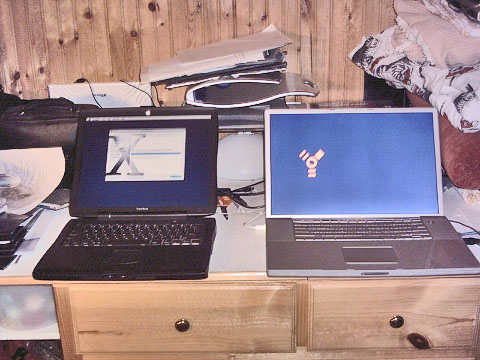
What are my Pismo’s future prospects? The only hardware issue I know of is that the display, never the Pismo’s most appealing feature, seems to be gradually succumbing to the dreaded “pink screen” defect that has plagued some Pismos. The display backlight has a distinctly pink tinge upon first waking or starting up. This clears after a while, but it’s been getting more noticeably worse lately, and I may be faced with replacing the backlight tube.
With the 550 MHz G4 and its 1 MB of L2 cache, the old Pismo still acquits itself surprisingly well for tasks that don’t involve a lot of Finder graphics support, and for actual image editing, Photoshop Elements 4.0 and Color It! 4.5 both perform quite satisfactorily. Quartz Extreme and Core Image are not supported by the RAGE 128 Mobility GPU, however, and I don;t really consider the Pismo to be quite adequate anymore as a production platform.
It will be interesting to see if Apple continues to support the Pismo with the OS X 10.5 Leopard release, and if they adjust the cut-off threshold at G4 processors, will a G4-upgraded Pismo qualify. Not a major big deal, as my take is that OS 10.3.9 is the optimum performance system for the Pismo anyway, and Tiger is supported if you can’t live without Spotlight and/or the Dashboard.
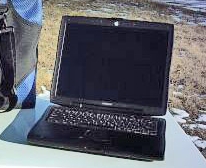
Still, I love the Pismo’s versatility, and that 8x Fastmac SuperDrive is twice as fast as the one in my 17” PowerBook, plus the Pismo plays nicely with both of my scanners. I expect I’ll be using it for some time yet as a utility machine.
Digg this del.icio.us